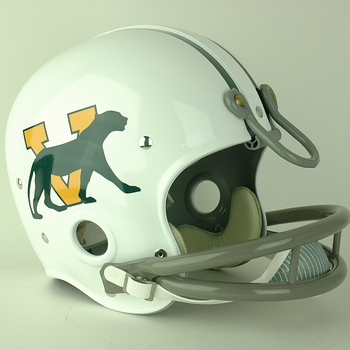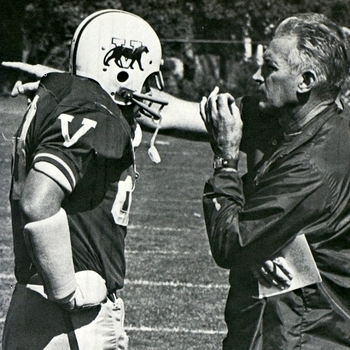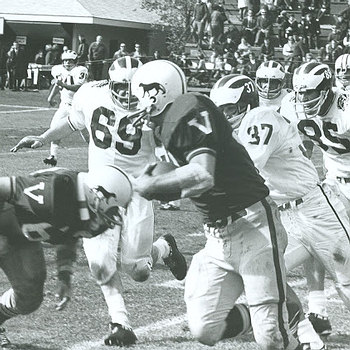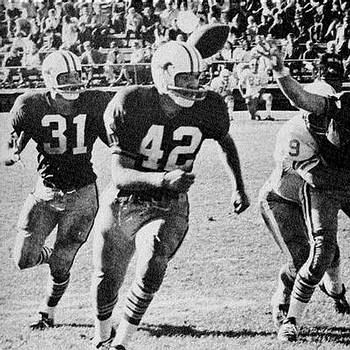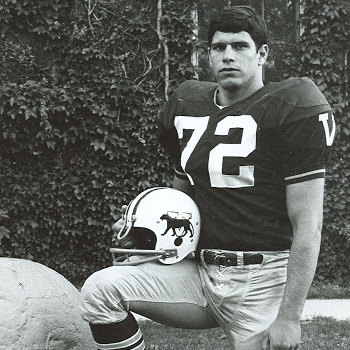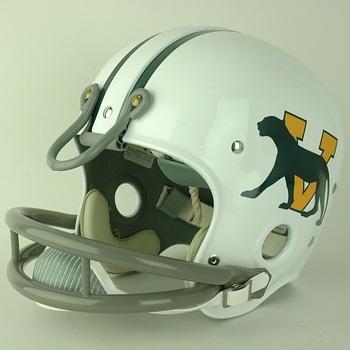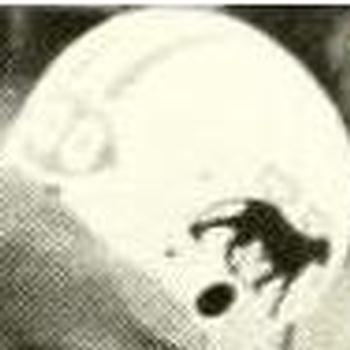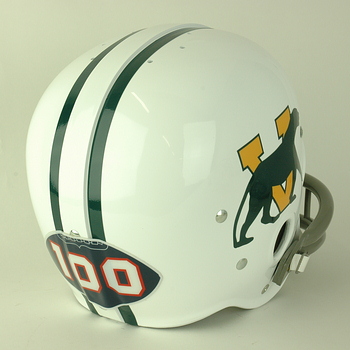
Vermont
1969 Catamounts
(Authentic Reproduction)
Two previous
HELMET HUT
features about the University Of Vermont football program were very well
received, but it was surprising that so few of our readers were aware that
Vermont had fielded a football team at one time. It may be rather obvious
that a minimal number of National Football League players came from their
program and of the six who did, only one played in the AAFC with the five
others, products of the 1920s, yet they often had good teams and as noted in
our two other articles, [ see HELMET HUT
http://www.helmethut.com/College/Vermont/VermontIndex.html
]
many of
their best players were part of Head Coach Bob Clifford’s teams of the mid
to late-1960s. As a member of the Yankee Conference, Vermont earned respect
in the Northeast region. The conference recruited locally and usually had
players a step too slow or a few inches too short for Boston College, Penn
State, and Syracuse, but as a “small college” conference, it was often among
the best and routinely had players that gained national recognition. Vermont
may have been jammed in the middle of the pack at the conclusion of most
seasons, but they were just as often solid and under Clifford, played hard.
A former Williams College assistant and Colby College head coach, Clifford
knew that he always had to make the most of his material.
Captained
by offensive tackle David Lucaroni who completed his UVM career as a
two-time All Conference honoree, the return of twenty-five lettermen and an
influx of talent from an undefeated 4-0 freshman squad of the ’67 season
made hopes run high for 1968. With that air of expectation came an
alteration of their existing helmet design. The squad had worn a white shell
with dark green flanking stripes and dark green “walking Catamount” decals
on each side. The helmet was dressed up a bit with a change in the decal
that now featured the same Catamount design placed upon an underlying Green
Bay gold “V” that was outlined in dark green.
Bob Mitchell runs against
the University Of Maine in 1967. Coach Clifford updated the helmet for the
1968 season.
As the
season began, Coach Clifford and his staff expected a lot more than the 3-6
record that eventually resulted from the 1968 season. There was certainly
work to be done on offense with the graduation of Little All American
halfback and school record setter Bob Mitchell as well as ends Keith
Keiderling and Jeff Kuhmann but the real problem arrived as the injury rate
soared. The toll was heavy, at one point leaving but thirty-eight players
able to suit up and represent the University at game time. However, the
defense looked big and loaded, especially with Ron Tice, tackle Paul Ardell,
linebacker John Wojciechowski, and defensive end Harry Canning, who had come
to Vermont as a highly touted running back from Plattsburgh, N.Y. St. John’s
Academy.
Francis
Peterson, a fine athlete who had been a starting defensive back and punt
returner as a sophomore in ’67, was shifted to quarterback. After failing to
generate significant offense in the first seven games of the season and
limited by injuries to four running backs, former UVM star Mitchell, serving
as the frosh team assistant coach after being cut in the Denver Broncos
camp, pushed to move Canning to the running back position. Clifford took
action and moved Canning, perhaps his best defensive player, to halfback in
the UVM Triple Option offense against Williams College and gave him the
football.
Playing both ways, Canning gained a school record 292 yards on thirty-three
carries and another 171 against C.W. Post in the season finale, thus his 463
yards and 7.5 yards per carry average led the squad. Gerald Elliot filled
the defensive end spot superlatively and was named to the All New England
team as a sophomore. If nothing else, the team had adapted its material and
expectations were elevated for 1969.
1969
brought excitement based upon the manner in which the ’68 season finished,
and the 100 Year of College Football Anniversary sticker was affixed to the
rear of all of the Vermont helmets that carried forth the design alterations
of 1968.
Still in
gear with the Triple Option, it was expected that “Lighthorse” Harry Canning
who had single-handedly given the Catamounts a rushing attack at the end of
the ’68 campaign, would continue his assault on the UVM record book. However
fall camp uncovered another rushing gold nugget in sophomore Bob Rodger and
the versatile Canning who had also been such an outstanding defensive end,
was moved to fullback. Francis Peterson, again at the controls, and
operating behind big 6’6”, 275 pound tackle Bob Lynch, added another
dimension to the offense, passing for 1108 yards and nine touchdowns, and
was exceptional as a leader. He personally set eleven of the twenty-one new
UVM offensive marks that the team recorded and was named to the All Yankee
Conference, All New England, and All East Coast teams. On the other end of a
new school, conference, and New England record fifty-one receptions for 573
yards and seven touchdown catches was former kick and punt return specialist
Gene Monahan who excelled at the end position. The offense was potent but it
was Rodger who truly stood out, with a new school rushing record of 1158
yards and eleven rushing touchdowns. Despite numerous individual accolades
that included ECAC Division II Sophomore Of The Year recognition for Rodger,
the won-lost record was a repeat of the 3-6 of ’68.
The
defense, again anchored by Second Team All New England defensive end Gerald
Elliott who put his wrestling skills to good use, was generally stout enough
to win more games but had some critical breakdowns, especially against
UMass. Linebacker Kevin Lynch and defensive guard Larry Kull also stood out,
with the latter twice winning ECAC Division awards as Lineman Of The Week.
Despite having given Vermont some of their best seasons in the mid-1960s,
the disappointment of ’68 and 1969 left Clifford out and paved the way for
new head coach and former CFL Montreal Alouettes Offensive Coordinator Joe
Scanella. Clifford however, could be proud of his body of work and the type
of individuals he helped to develop. Quarterback Peterson completed his
career as a Dean’s List student in Biology and attained a PhD in nutritional
biochemistry from Cornell. Ron Tice became a successful attorney who
eventually settled in the Toledo, Ohio area while Canning, who had such a
marvelous season in ’68, became a highly respected high school Computer
Science teacher and football coach in his native upstate New York. Monahan
too taught and coached for years in New Jersey. Elliott completed his career
in 1970 on Scanella’s first squad. Despite a winless senior year in which he
served as team captain, he completed his stay at UVM as an All ECAC player
who was not only All Yankee Conference but the Defensive MVP. He was also
Vermont’s best wrestler and took his skills and awards first to the Hartford
Knights of the Atlantic Coast Football League where he was a league All Star
after going through the New England Patriots camp, and completed his
football sojourn with the Hamilton Tiger Cats of the CFL for the 1972
season. A cum laude student, Elliott earned a Masters Degree in Political
Science and like a number of his teammates, became a respected high school
instructor and coach.
While the
demise of the Vermont football program following the 1974 season has left a
void, the obvious quality of the student-athletes that were drawn to both
attend school and represent the beautiful university in collegiate athletics
resonated for years. The club level team that now represents the Catamounts
is a true reflection of the dedicated student-athlete and is a reminder that
the re-establishment of football as a varsity sport would certainly enhance
the fall season in the magnificent Vermont setting.


